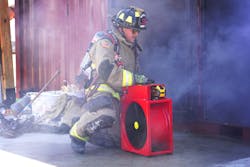Lyons, IL, Fire Department (LFD) Fire Chief Gordon Nord Jr. is a proponent of the implementation of positive pressure ventilation (PPV) on the fireground.
“The days of old, when you’d break every window in sight or open every overhead door, are over,” Nord remarks. “With PPV, it’s best to have one opening to blow into and one opening that’s double the size of the first for the smoke to exhaust from, as this allows the building to hold in the pressure and direct the smoke out effectively.”
(Editor's Note: Experts, including UL Fire Safety Research Institute, say that the exhaust opening size depends on the type of structure that's being ventilated but usually should be two to three times the size of the inlet opening.)
Nord also is a believer in the evolution of the design of PPV fans to operate on battery power.
“They’re quick to put into operation, are very versatile and don’t cause a concern of carbon monoxide,” he says.
However, Nord is concerned about units’ runtime and the onus that puts on members to keep replacement batteries charged. He and others for which this causes trepidation might find relief in knowing of Tempest’s VS Tech Series models. Depending on the brand of battery (models in the series accept DeWalt, Hurst, Milwaukee and the company’s proprietary unit), the fan can be connected to as many as three batteries at once.
As one of the batteries gets to the end of its charge, the system instantaneously switches to the next battery. The user won’t notice the switchover. As a result, for example, the version of the fan that operates on Milwaukee battery technology (model VS-1.3M) provides an average runtime of 65 minutes when three batteries are loaded into the battery cradle.
Tempest’s Sam Jessup says that members of the Fresno, CA, Fire Department have praised the fan’s capability to allow them to run the fan at two or three fires without the need for battery recharging.
“When we first started [the development of the VS Tech Series], we were aiming at lower weight” compared with that of corded fans, Jessup explains, “but the biggest draw has been the greater convenience for the firefighters.”
Brian Gettemeier, who is an engine company captain with the Cottleville Fire Protection District of St. Charles County, MO, appreciates manufacturer efforts regarding runtime. He also is complimentary of their work to increase power. The Tempest VS-1.3M, for instance, delivers 10,000 CFM.
In general, Gettemeier says, “Battery-powered fans are getting into service faster, and we aren’t wondering whether they will start in heavy smoke conditions.” He also commends them for their quiet operation, which makes them “better for our hearing, better for fireground stressors and better for fireground communications.”
Smoke ejectors
As with the development of Tempest’s battery-powered PPV fans, the crafting of Super Vac’s P-164 16-inch battery-powered smoke ejector resulted in a reduction in weight. Compared with the 44-lb. weight of the company’s comparable electric model, the P-164, depending on brand of battery (DeWalt, Makita or Milwaukee), can be as much as four pounds lighter. Of course, the weight difference is even greater in comparison with gasoline-powered models.
The P-164 was introduced at in 2024, but the company had a demonstration unit in mid-2023, to get reaction to it. That included at the NYSAFC annual conference.
A video of the smoke ejector was captured and posted, and it went viral, Super Vac’s Dana Shaffer tells Firehouse. As a result of interest that was garnered from more than 2 million views, “We were forced to pick up our pace of final design and get the P-164 to market as soon as possible,” Shaffer notes.
Upon learning of the smoke ejector’s introduction, the West Islip, NY, Fire Department replaced the electric smoke ejectors on all of its rigs with the P-164, Shaffer says.
The unit only is offered in a 16-inch version; however, its 6,700-cfm performance exceeds the 5,200 cfm of the company’s comparable electric model.
The inherent light weight of battery-powered smoke ejectors and the obvious cutting of the cord are key to the Meridian, ID, Fire Department’s (MFD) move away from electric and gasoline-powered models.
“Battery-powered fans offer operational versatility, cost-effectiveness, safety and environmental benefits,” MFD Fire Chief Kristopher Blume stated when asked about product improvements that have aided his department’s horizontal and vertical ventilation operations in the past 18 months. Firehouse sought Blume’s input in particular because of him authoring “Small Towns, Big Box Retailers: Challenges and Strategies for Firefighters” and “Pre-Incident Planning for Big Box Fires for Small Fire Departments”.
The operational versatility of battery-powered fans (i.e., their portability) makes them ideal for remote or challenging locations, including big box retailers but also in stairwells in a high-rise, Blume believes.
“Although initial costs may be higher, long-term savings from lower energy use and maintenance make them cost-effective,” he adds.
MVUs
What’s in the offing for the design of PPV fans and smoke ejectors? Tempest’s Jessup says his company is looking for other options that will provide further convenience for firefighters, but he stopped short of revealing specifics. He did share that battery power for fans that are larger than 48 inches is something that the company would like to explore.
“We just don’t know what that would look like yet,” he concedes, citing the technology for a battery that would power such a model and its affordability.
Of course, the size that Jessup notes leads into the realm of the mobile ventilation unit, or MVU, which can come into play for fires at large warehouses and data centers, among other incidents. This prospect appeals to LFD’s Nord.
“A battery-powered unit would be a huge improvement in MVU operations,” he offers.
“Although an MVU is very effective in removing smoke from large areas quickly, one drawback is the [gasoline-powered] motor creates exhaust,” Nord continues. “Exhaust induced into the air stream from the fan can cause carbon monoxide issues in the building that you’re trying to ventilate. We attach an exhaust hose to the MVU exhaust to try to make the exhaust less of a factor.”
“I could see important uses and implementation opportunity for large metro departments,” Blume adds, “or, more specifically, agencies with high-rise, confined space or big box stores,” a key benefit being, again, the capability of moving a massive amount of air volume without adding additional fuel emissions to the emergency scene. Blume wonders whether the continuing development of brushless DC motors might aid in the development of
battery-powered MVUs.
All this said, Gettemeier warns that positive pressure attack shouldn’t be implemented based on one department member reading an article or watching a video. For example, ventilation of warehouses is very challenging, he says.
“Sprinkler operations will create cold, lazy smoke, which is difficult if not impossible to move,” Gettemeier explains. Further, “Given the cubic footage of a warehouse, it’s difficult to pressurize the container to push out or suck out the smoke.”
Coordination
Gettemeier isn’t alone when he expresses caution about positive pressure and negative pressure ventilation, whether of the horizontal or vertical variety. Many a training officer spends substantial time stressing the importance of communication and coordination. For instance, roof crews once cut ventilation holes as soon as they located themselves in the proper position, even before interior crews were in place to put water on the fire. However, the result of airflow studies revealing that ventilation without coordination with those who operated on the interior just caused flames and smoke to emit with pressure from the vent hole rather than make the interior environment safer for firefighters operating the attack hose.
“It can’t be stated enough that coordination of ventilation be done through clear and effective comms between command, interior crews and vent crews,” Dave Roberston, who is the fire chief of the Fort Frances Fire Department in Ontario, Canada, emphasizes.
Undoubtedly, the equipment that manufacturers of PPV fans and smoke ejectors have and are developing will aid in the process.
“Whatever people are asking for or maybe that they don’t even know that they need, we’re exploring that,” Tempest’s Jessup guarantees.
Something to Sink Your Teeth Into
As Firehouse reported in “Amped Up: Cutting-Edge Battery-Powered Tools” (firehouse.com/21249612), the evolution of the technology that’s employed in equipment that’s used on the fireground and at rescue incidents is underway. That includes chainsaws and their battery-powered design.
“No longer are we wondering if the saw will start on the roof,” Brian Gettemeier of the Cottleville Fire Protection District of St. Charles County, MO, says of the growing availability of battery-powered chainsaws that are used for vertical ventilation and how they aren’t affected by smoke, as gasoline-powered models can be.
Not only are there more offerings, but the variety of brands of batteries that can be used has grown, too. As a result, so has the strength (read: torque) of chainsaws, which facilitates faster chain speeds, to improve roof-cutting operations. In conjunction with that, Super Vac found departments asking for a more durable chain, to stand up better to the potentially two or three layers of shingles that they might encounter.
Super Vac’s Dana Shaffer tells Firehouse that a second raker that was added to the chain that the company offers among its conversion kits clears roofing material from in front of the cutting tooth, which in turn allows the cutting tooth to do its job to cut through plywood.
“We found the new Chisel X chain outperforms our single-raker Chisel E chain in cutting distance by nearly 40 percent,” Shaffer says. “Basically, on the Chisel E, we were getting anywhere from 92 feet to 106 feet of cuts out of a chain before it had to be disposed of.” The 40 percent improvement that’s delivered by the Chisel X equates to chain endurance in the range of 130–150 feet of cuts.
About the Author
Rich Dzierwa
Managing Editor, Firehouse Magazine
Rich Dzierwa joined Firehouse Magazine in 2019 after four tenures with other publications. He was editor-in-chief of Consumers Digest/ConsumersDigest.com and of trade magazine Cutting Tool Engineering. He served as the consumer products reporter for BridgeNews and began his publishing career with an 11-year tenure at Appliance magazine, where he rose to managing editor after serving in other roles. Dzierwa's experience with consumer products, including furnishings, appliances, electronics and space design, has transferred to his Firehouse work regarding the magazine's Station Design columns and the Station Design Awards. Previous work also has contributed to his supervision of several surveys of fire service/EMS members, to produce unique reporting for Firehouse's audience. Dzierwa earned a bachelor's degree in English from Columbia College Chicago.

